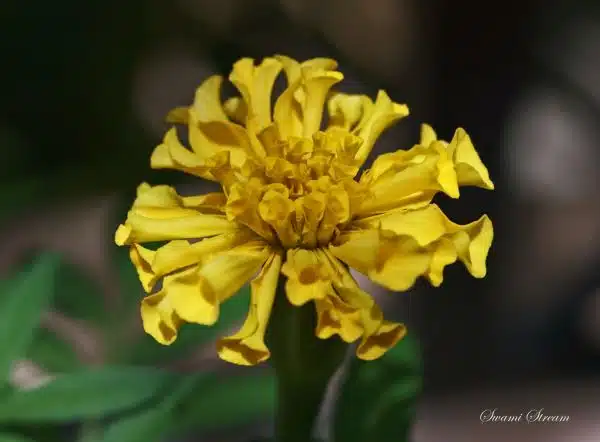Growing African Marigolds, also known as Mexican Marigolds, is a great way to add vibrant colors and unique textures to your garden. These hardy annuals are easy to grow and can provide you with beautiful blooms throughout the growing season. In this article, we will explore the steps needed to successfully cultivate these plants, including tips on soil preparation, planting techniques, and maintenance.
African Marigolds are native to Mexico and Central America but have become popular worldwide due to their attractive appearance and ease of cultivation. They are commonly used in flower beds, borders, and containers for their striking orange or yellow flowers that bloom from summer until fall. These plants prefer full sun exposure and well-draining soil but can tolerate some shade and dry conditions. With the right care, African Marigolds can thrive in a variety of settings and add a touch of beauty to any landscape.
Understanding African Marigolds
African marigolds, also known as Mexican marigolds, are popular annual flowers that belong to the sunflower family. These brightly colored plants can reach up to three feet in height and produce an abundance of blooms throughout the summer months. Interestingly, African marigolds are not only grown for their ornamental value but also have a variety of uses in traditional medicine.
African marigold has been used for centuries as a natural remedy for various ailments. The plant contains compounds that have anti-inflammatory and antiseptic properties, making it useful in treating minor wounds and skin irritations. Ingesting the flowers or leaves of the plant is believed to help ease digestive issues such as bloating and cramping. Additionally, African marigold is often used in teas or as a topical ointment to alleviate symptoms associated with menstrual cramps.
Beyond its medicinal uses, African marigold plays an important role in local ecosystems. The flowers produce nectar that attracts bees, butterflies, and other pollinators. The leaves contain compounds that repel certain pests such as aphids and whiteflies. This makes them a valuable addition to companion planting schemes where they are grown alongside vegetables such as tomatoes or peppers. African marigolds are also commonly planted as cover crops to help suppress weeds and improve soil health.
As you begin your journey of growing African marigolds, it’s important to understand their significance beyond just being pretty flowers. By choosing the right location for planting them, you can ensure they thrive both aesthetically and ecologically.
Choosing The Right Location
- African marigolds (Mexican marigolds) require at least 6 hours of direct sunlight per day to thrive, so it is important to select a planting site with ample sunlight exposure.
- The soil should be well-drained, with a slightly acidic to neutral pH range, and enriched with organic matter like compost.
- Furthermore, it is beneficial to ensure that the planting site is sheltered from strong winds, which can dry out the soil and damage the plant.
- Finally, African marigolds should be grown in an area with plenty of space to allow the plants to reach their full potential.
Finding Sunlight
Maximizing the growth of African marigold requires sufficient sunlight. This vibrant flower needs at least six hours of direct sunlight each day to thrive. When choosing a location to grow African marigolds, it is crucial to find an area that receives maximum exposure to the sun. Consider planting them in an open and sunny spot with no obstructions that can block the sun’s rays.
However, intense heat and prolonged exposure to direct sunlight can damage African marigolds. Therefore, creating shade solutions is vital for their growth and survival. You can achieve this by using a shade cloth or planting taller plants like sunflowers around your African marigold garden. These options will help reduce the intensity of direct sunlight while still providing enough light for optimal growth.
In conclusion, finding adequate sunlight for African marigold is critical in maximizing its growth potential. Choosing a location with maximum exposure to the sun while also creating shade solutions will yield excellent results for this beautiful plant. With these tips, you are well on your way to growing healthy and thriving African marigolds in your garden.
Soil Requirements
When choosing the right location for growing African marigolds, considering soil composition is just as crucial as ensuring adequate sunlight exposure. These flowers thrive in well-draining soils with a pH level between 6.0 to 7.0. The ideal soil type for African marigold growth is sandy loam, which provides excellent drainage and sufficient moisture retention.
The soil’s nutrient content is also essential in maximizing the plant’s growth potential. Before planting, it is recommended to amend the soil with organic matter such as compost or well-rotted manure to improve nutrient availability and promote healthy root development. Additionally, regular fertilization throughout the growing season can help maintain optimal nutrient levels.
It is essential to monitor the soil’s pH level regularly since an imbalanced pH can affect nutrient absorption and plant growth. If necessary, adding lime or sulfur can help adjust the pH level accordingly. By considering these factors when selecting a location for your African marigold garden, you can ensure that your plants have the proper soil requirements for healthy and thriving growth.
Soil Preparation
Soil Preparation:
One of the essential aspects of growing African marigold (Mexican marigold) is soil preparation. The first step in soil preparation involves soil testing to determine the pH level, nutrient content, and texture. Soil testing helps gardeners decide on the appropriate amendments to improve the soil quality for optimal plant growth.
The ideal soil pH range for African marigold is between 6.0 and 7.0. If your soil is too acidic, you can add lime to raise the pH level. On the other hand, if your soil is too alkaline, you can add sulfur to lower its pH level. Moreover, amending your soil with organic matter like compost or aged manure can help improve its texture and water-holding capacity.
After determining the appropriate amendments for your soil, you can proceed to prepare your planting bed by incorporating them into the topsoil using a garden fork or tiller. Ensure that you mix thoroughly to distribute the amendments evenly throughout the soil profile. By following these simple steps, you will provide an excellent environment for growing healthy and robust African marigolds that will grace your garden all summer long.
Transition: Now that we have covered how to prepare your planting bed adequately, let us move on to learn about fertilizing your plants for optimal growth and performance.
Fertilizing Your Plants
As a horticulturalist or gardening expert, it is important to know how to fertilize African Marigold plants. Fertilizer provides essential nutrients to the soil and helps the plants grow healthy and strong. When choosing a fertilizer, organic options are always recommended as they are safe for both the environment and the plant itself.
The frequency of fertilizing your African Marigold plants depends on several factors. The type of soil you have and its nutrient content, as well as the stage of growth your plants are in, will all play a role in determining how often you need to fertilize. As a general guideline, it is recommended that you fertilize once every two weeks during the growing season. However, be sure to monitor your plants closely for signs of over-fertilization such as yellowing leaves or stunted growth.
Organic options for fertilizing your African Marigold plants include compost tea, worm castings or fish emulsion. These options are great choices because they provide not only essential nutrients but also beneficial microorganisms that help keep your soil healthy. Be sure to follow the instructions provided with each product carefully to ensure proper application and avoid over-fertilization which can harm your plants. In combination with proper watering and sunlight exposure, fertilizing with organic options will help ensure a bountiful harvest of beautiful African Marigolds in no time!
When planting seeds or seedlings for your African Marigold garden, there are several important steps that should be followed to ensure success. First, choose an area with well-drained soil that receives plenty of sunlight throughout the day. Next, prepare the soil by removing any weeds or debris and adding compost or other organic matter if necessary. Finally, plant your seeds or seedlings according to package instructions and water thoroughly. With proper care and attention throughout the growing season, you’ll be rewarded with a stunning display of colorful blooms come harvest time!
Planting Seeds Or Seedlings
Planting seeds or seedlings is an important step in the growth process of African Marigold. There are two methods to plant them: starting indoors and direct sowing outdoors.
Starting indoors involves planting the seeds in flats or pots filled with a high-quality seed-starting mix. It is best to plant four to six weeks before the last expected frost date of your region. Once planted, place the containers in a warm and sunny spot with consistent moisture levels. After germination, provide adequate light by placing them under grow lights or near windows.
Direct sowing outdoors requires good soil preparation. Start by loosening the soil and removing any weeds, debris, or rocks that may inhibit growth. Sow seeds directly into well-drained soil around two weeks after the last expected frost date of your area. Ensure that there is ample sunlight for optimal growth and add water regularly to keep the soil moist until germination occurs.
Transition sentence: Now that you have successfully planted your African Marigold seeds, it’s time to learn proper watering techniques for their continued growth and development.
Watering Techniques
After planting african marigold seeds or seedlings, it is important to maintain proper watering practices for optimal growth. The best watering practices for african marigolds includes a deep and thorough watering once a week, rather than frequent shallow waterings. This encourages deeper root growth and establishes drought tolerance in the plants.
One common watering mistake many gardeners make is over-watering their african marigolds. Over-watering can lead to root rot and other fungal diseases, causing damage to the plant’s health. To avoid this mistake, use a well-draining soil mixture that allows excess water to drain away from the roots easily.
Another common watering mistake is under-watering the plants. African marigolds thrive in moist soil environments, so it’s important to ensure that they receive adequate water throughout their growing period. Regularly check the soil moisture levels by inserting your finger into the soil up to your second knuckle; if it feels dry at this depth, water the plant immediately.
To further promote healthy growth of your african marigolds, consider mulching for moisture retention. Mulch helps to conserve soil moisture by reducing evaporation and suppressing weed growth around the plants. This also provides insulation for the roots during extreme weather conditions such as hot summer days or cold winter nights. By practicing proper watering techniques and incorporating mulching into your gardening routine, you can ensure successful growth of your african marigolds.
Mulching For Moisture Retention
Mulching for Moisture Retention:
Mulching is a crucial technique in gardening that offers a range of benefits to plants. African marigolds or Mexican marigolds thrive well in well-drained soils and require adequate moisture to grow healthily. Mulching offers an excellent way to retain soil moisture, which is essential in promoting the growth and development of these beautiful flowers. By covering the soil with organic or inorganic materials, you can shield the soil from direct sunlight, reduce water evaporation, and maintain optimal soil moisture levels.
There are several types of mulch available for gardeners to use when cultivating African marigolds, including organic and inorganic materials. Organic mulches such as straw, grass clippings, leaves, or shredded bark decompose into the soil over time and enrich it with nutrients. On the other hand, inorganic mulches such as pebbles or rocks do not decompose but provide a long-lasting solution to retaining moisture. Regardless of the type of mulch you choose to use for your garden, ensure that it does not contain weed seeds.
Benefits of mulching are numerous and include preventing weed growth around your plants while also providing natural pest control by deterring pests from reaching your plants’ roots. Mulch also helps maintain stable temperatures around your plants’ roots by insulating them from temperature fluctuations caused by extreme weather conditions.
In conclusion, mulching offers an effective way to promote healthy growth for African marigolds while also reducing maintenance requirements for gardeners. Using organic or inorganic mulches can help retain soil moisture while also improving nutrient content within the soil bed. In the next section about pruning to promote growth, we will cover how cutting back certain parts of African marigold plants promotes healthy flowering habits without damaging them.
Pruning To Promote Growth
Mulching is an essential gardening practice that helps retain soil moisture, reduce weed growth, and promote healthy plant growth. When it comes to growing African marigold, mulching should be done after planting the seedlings. A layer of organic mulch, such as dried leaves or grass clippings, should be spread evenly around the base of the plants to a depth of 2-3 inches.
Pruning techniques play a vital role in promoting the growth and blooming of African marigolds. Pinching off the tips of young plants when they reach six inches tall will encourage bushy growth and more flowers. Deadheading spent blooms is also crucial since it promotes continuous flowering throughout the growing season. Timing for pruning is important since African marigolds require some time to establish themselves before being pruned.
Dealing with pests and diseases can be challenging for any gardener, but there are several measures that can be taken to prevent them from affecting your African marigold plants. One effective method is to regularly inspect your plants for signs of pests and diseases, including yellowing leaves, wilting or scarring on leaves or stems. Another approach is to plant companion plants that repel pests naturally or use organic solutions such as neem oil or insecticidal soap. By consistently monitoring your plants’ health, you can identify potential problems early on and take action before they cause significant damage.
Dealing With Pests And Diseases
Preventative measures are the first line of defense against pests and diseases in African marigolds. It is essential to keep the plants healthy by providing adequate sunlight, water, and nutrients. Overwatering can lead to root rot and fungal diseases, so it is important to water only when necessary. Additionally, avoid overcrowding plants as this can create a humid environment that encourages fungal growth.
If pests or diseases do occur, there are several natural remedies that can be used to combat them. For instance, aphids and other soft-bodied insects can be controlled by spraying the plants with a solution of water and dish soap. This solution should be used sparingly as it can also harm beneficial insects like ladybugs.
Another natural remedy for pest control is planting companion plants such as garlic or chives around the African marigolds. These plants release compounds that repel pests and deter them from attacking your marigolds.
In summary, prevention is key when dealing with pests and diseases in African marigolds. Maintaining healthy growing conditions for your plants is paramount; however, if issues do arise, natural remedies such as soap solutions or companion planting can help control pests without harming beneficial insects. In the next section, we will explore supporting your plants to ensure they reach their full potential.
Supporting Your Plants
Now that you have learned how to deal with pests and diseases, it is important to focus on supporting your African marigolds. Supporting your plants will ensure they grow strong and healthy, producing more vibrant flowers. Staking tips are essential for keeping your African marigolds upright and preventing them from falling over due to their heavy blooms. You can use bamboo sticks or metal rods to stake them up, ensuring the stakes are taller than the plants.
Another method of supporting your plants is trellising. Trellising methods vary depending on the growth habit of the plant, but in general, you want to provide a structure for the plant to climb or attach itself to. For African marigolds, using a wire mesh trellis can be effective in guiding their growth upwards. This method not only supports the plant but also allows for better air circulation around the foliage.
By providing support through staking or trellising, you can prevent any damage from strong winds or heavy rains and ensure that your African marigolds don’t topple over. Additionally, by lifting them off the ground, you reduce the likelihood of pests and diseases affecting your plants. As you continue caring for your African marigolds, consider incorporating these techniques into your routine so that they thrive throughout their growing season.
As we move towards harvesting and saving seeds from our African marigold plants, it’s essential that we pay attention to specific details like maturity dates and seed collection methods. Harvesting seeds too early may lead to low germination rates while leaving them on for too long might result in mold growth on the flower heads. Once matured, collect seeds by gently removing their dried flower heads using pruning shears or scissors into a paper bag or envelope before storing them away in a cool dry place until next planting season arrives.
Harvesting And Saving Seeds
Once the African marigold blooms start to fade, it is time to harvest the seeds. It is important to let the flowers dry out completely before harvesting the seeds. Once the flower heads are dry, they can be gently rubbed between your fingers or palms, releasing the seeds. Collect these seeds in a paper bag or envelope and store them in a cool, dark place until you are ready to use them.
Seed storage is crucial for ensuring that your African marigold seeds remain viable for future planting seasons. Make sure that the paper bag or envelope you store your seeds in is completely dry before sealing it shut. Moisture can cause mold growth and damage to the seeds, rendering them unusable. Additionally, it is important to label your seed container with both the date and variety of seed so that you can keep track of their age and origin.
When it comes time to plant your saved African marigold seeds, there are several propagation methods you can choose from. You could start them indoors 4-6 weeks before your last frost date or sow them directly into well-draining soil in late spring after all danger of frost has passed. Regardless of which method you choose, make sure that the soil stays moist but not waterlogged until germination occurs. With proper care and attention, you’ll soon have another beautiful crop of African marigolds!
To propagate African marigolds using cuttings instead of seeds requires a different set of steps.
Propagating African Marigolds
Seeds for African Marigolds can be collected from the flowers when the petals begin to fade, but before the seed heads become dry and brittle. Plant the seeds in a sunny area with well-drained soil and cover lightly with soil. When the seedlings have grown to a few inches tall, thin to 6-12 inches apart. To ensure healthy growth, water regularly and provide a balanced fertilizer during the growing season. Deadheading spent blooms will also help to promote continued blooming. In addition, to protect the plant from disease and pests, it is important to practice good cultural practices, such as proper spacing, cleaning up debris and avoiding overcrowding. With proper care and maintenance, African Marigolds can be grown successfully in any garden.
Seed Collection
To propagate African marigolds, collecting seeds is an essential step. It is important to wait until the flowers have fully bloomed and the petals have fallen off before harvesting the seeds. This ensures that the seeds are mature and viable for planting. To collect the seeds, gently break apart the dried flower head over a piece of paper or container to catch any loose seeds.
Proper storage of collected marigold seeds is crucial for successful propagation in future growing seasons. The best way to store them is in a cool, dry place such as a refrigerator or freezer. Before storing, make sure to remove any remaining plant debris and moisture from the seeds. Additionally, DIY packaging using small paper envelopes or plastic bags labeled with the date and plant variety can help keep track of seed collection.
Collecting and storing African marigold seeds can be a fulfilling experience for gardeners looking to propagate their favorite plants. By following these steps for proper seed collection and storage, gardeners can ensure that their marigolds thrive year after year.
Planting
Now that you have collected and stored African marigold seeds, the next step is planting them. Proper seed spacing is crucial for healthy growth and development of the plants. A distance of 6-8 inches between each seed is recommended to allow for adequate air circulation and prevent overcrowding. The seeds should be planted in well-draining soil with a pH level between 6.0-7.5.
Germination time for African marigold seeds typically ranges from 5-14 days depending on the growing conditions. For optimal germination, the soil temperature should be around 70°F (21°C) and kept consistently moist but not waterlogged. It’s important to avoid allowing the soil to dry out completely or overwatering, as both can lead to poor germination rates or even seed rot.
Once the seedlings have emerged, it’s essential to thin them out by removing any weaker or damaged plants, leaving only the strongest ones to grow. This will help prevent competition for nutrients and sunlight and promote healthier plant growth overall. With proper planting techniques and care, your African marigold seeds are sure to thrive and produce beautiful blooms in no time!
Care & Maintenance
After successfully propagating your African marigold seeds, it’s time to focus on their care and maintenance. Proper care can help ensure that your marigolds produce healthy and vibrant blooms throughout the growing season. Common problems that may arise include pests such as spider mites and aphids, as well as fungal diseases such as powdery mildew. Troubleshooting tips for these issues include using natural pest control methods like neem oil or insecticidal soap, as well as removing infected leaves and practicing good garden hygiene.
Seasonal care is also important for African marigolds. During the summer months, they require regular watering to keep the soil moist but not waterlogged. In addition, fertilization with a balanced fertilizer every 2-3 weeks can help promote healthy growth and flowering. As fall approaches, it’s important to deadhead spent blooms regularly to encourage new growth and prevent self-seeding.
Winterization is crucial for ensuring that your African marigolds survive the colder months. Before the first frost, cut back any remaining foliage and cover the soil with a layer of mulch to protect the roots from freezing temperatures. If you live in a particularly cold climate, you may need to dig up your plants and store them indoors until spring. With proper care and maintenance throughout the growing season, your African marigolds are sure to thrive and bring joy to your garden or landscape.
Using African Marigolds In Your Garden Design
After all the effort put into propagating African marigolds, it’s time to use them in your garden design. These flowers are known for their bright and vibrant colors which can be used to create stunning color schemes in your garden. Companion planting is another important aspect to consider when designing a garden with African marigolds.
When choosing companion plants for your African marigolds, make sure they have similar light and water requirements. Some great companions for these flowers include zinnias, cosmos, and salvia. Not only do they share similar needs, but their colors also complement each other well. Mixing different shades of orange, yellow, and red can create a warm and inviting atmosphere in your garden.
Growing African marigolds in containers is another way to add this beautiful flower to your garden design. The process is simple: start with a container that has good drainage holes, fill it with good quality potting mix, and plant the seeds or seedlings according to the instructions on the packet. Make sure to water regularly and fertilize every few weeks. Containers are great for those with limited space or who want to move their plants around for different aesthetics throughout the season. With these tips, you can enjoy the beauty of African marigolds all year round!
Growing African Marigolds In Containers
When it comes to growing African marigolds, containers can be a great option for those with limited garden space or who want to add some color to their patio or balcony. However, choosing the right container size is crucial to ensure your plants thrive. African marigolds prefer well-draining soil and don’t like their roots to sit in water, so make sure your container has drainage holes. A depth of at least 6 inches is recommended, but larger containers can allow for bigger plants and longer blooming time.
In addition to proper container size, companion planting can also play a role in the success of your African marigolds. These sunny flowers do well when planted alongside herbs like basil or chamomile, which can help repel pests while promoting healthy growth. Other popular companion plants include tomatoes and peppers, as they have similar soil and watering requirements.
Overall, growing African marigolds in containers can be a rewarding experience that adds beauty and color to any outdoor space. With the right container size and companion planting choices, you can enjoy these vibrant blooms all season long. In the next section, we will discuss some tips for enjoying the beauty of your African marigolds once they are fully grown.
Enjoying The Beauty Of Your African Marigolds
African marigolds are known for their vibrant colors and beautiful blooms. In fact, these flowers are a popular choice among gardeners and horticulturists alike. According to recent surveys, African marigolds rank third in popularity among annual flowers grown in the United States.
If you want to enjoy the beauty of your African marigolds, there are many ways you can do so. One popular option is to create stunning flower arrangements with these blooms. They make a great addition to any bouquet or centerpiece, adding a pop of color and texture that is sure to impress.
Another way to enjoy your African marigolds is through photography. These flowers offer a stunning subject for macro photography, allowing you to capture the intricate details and textures of each bloom. With a few simple photography tips, such as adjusting your depth of field and using natural light, you can create stunning images that showcase the unique beauty of your African marigolds.
Frequently Asked Questions
Can African Marigolds Grow In Cold Weather?
Indoor cultivation of African marigolds is possible in cold weather using cold hardy varieties. These marigolds can withstand frost and even light snow, making them a great option for gardeners who live in regions with harsh winters. To ensure successful growth, it is recommended to start seeds indoors 6-8 weeks before the last frost date, then transplant them outdoors when the weather warms up. Additionally, providing adequate lighting and warmth during the indoor cultivation period will help promote healthy growth and strong roots. With proper care, African marigolds can thrive in colder climates and add vibrant color to any garden or landscape.
How Long Does It Take For African Marigolds To Bloom?
As the sun rises, fields of African marigolds bloom with radiant colors, painting a picturesque landscape. It takes around 45 to 50 days for African marigolds to bloom from seed. Growing techniques such as regular fertilization and proper watering can hasten the flowering process. Soil requirements include well-draining soil with a pH level between 6.0 and 7.5. A horticulturalist or gardening expert would emphasize the importance of selecting an appropriate location that receives at least six hours of sunlight per day for optimal growth and blooming. With these considerations in mind, gardeners can expect to enjoy the riotous display of vibrant flowers that African marigolds offer in their gardens or landscapes, bringing a touch of beauty and joy to those around them.
Do African Marigolds Attract Bees And Butterflies?
Attracting pollinators such as bees and butterflies is crucial for plant reproduction, making it important to consider when choosing plants to grow. African marigolds do attract bees and butterflies with their bright yellow and orange blooms, making them a great addition to any garden or landscape. However, if one is looking for alternatives to marigolds, there are many other plants that can attract pollinators such as lavender, coneflowers, and bee balm. It is essential to choose plants that are native to your region as they will thrive better in the local climate and soil conditions. Ultimately, providing pollinators with a variety of nectar-rich flowers will help support these important insects’ populations while also helping plants produce more fruit and seeds.
Can African Marigolds Be Used For Medicinal Purposes?
African marigold, also known as Mexican marigold, has been traditionally used for medicinal purposes due to its various benefits. The plant contains compounds that possess anti-inflammatory and antioxidant properties, making it useful in treating various conditions such as arthritis and inflammation. However, there is no standard dosage recommended for the use of African marigold for medicinal purposes, and further research is necessary to determine the most effective form of administration. Compared to other marigold varieties, African marigold is believed to have a higher concentration of these beneficial compounds. While African marigold shows promise as a medicinal herb, it should not be used without consulting a healthcare professional or trained herbalist.
How Do I Prevent African Marigolds From Becoming Leggy?
How can one prevent African marigolds from becoming leggy? Pruning techniques and optimal soil conditions are key factors in preventing this issue. Regular pruning is necessary to encourage bushier growth and prevent the stems from elongating. Pinching off the top of the plant when it reaches about 6 inches tall will promote branching, resulting in more flowers. Additionally, planting African marigolds in well-drained, fertile soil with a pH range between 6.0-7.5 will ensure healthy growth and minimize stress on the plant, which can also cause legginess. By implementing these practices, gardeners can enjoy fuller and healthier African marigold plants that produce more blooms for longer periods throughout the growing season.
Conclusion
African marigolds, also known as Mexican marigolds, are a beautiful addition to any garden. Despite being native to warmer climates, African marigolds can still thrive in colder weather with proper care. These plants typically take around 50-60 days to bloom and can attract bees and butterflies with their vibrant colors.
While African marigolds are primarily grown for their aesthetic value, they have also been used for medicinal purposes. The plant contains compounds that have anti-inflammatory and antiseptic properties, making it useful in treating minor cuts and bruises. However, it should be noted that these medicinal uses are not backed by extensive scientific research.
To prevent African marigolds from becoming leggy, it is important to pinch back the stems regularly. This will encourage the plant to grow bushier and produce more flowers. Additionally, providing adequate sunlight and watering the plant consistently can help promote healthy growth.
In conclusion, African marigolds are a stunning addition to any garden and can even serve some medicinal purposes. With proper care and attention, these plants can thrive in various weather conditions and attract beneficial pollinators. As horticulturalists or gardening experts, we must remember that like all living things, African marigolds require nurturing in order to reach their full potential – much like how a child needs guidance from parents or teachers to flourish into adulthood.
Image Credits
- “African Marigold” by Swami Stream (featured)





























